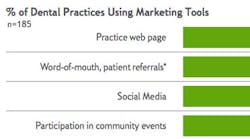Dental practices 'particularly bullish about the future,' survey reveals
The 2015 Citizens Bank Healthcare Outlook found 72% of small, privately held dental practices are predicting higher revenues over the next five years, compared to 37% of medical practices of similar size. The Citizens survey of the state of the industry for independent dental and medical practices included 450 practice groups with fewer than 10 doctors or dentists and revenue between $500,000 and $5 million.
“In addition to the critical roles they play in providing health care services, independent dental and medical practice groups run very sophisticated businesses with complicated cash flow dynamics and a lot of opportunities to either get it right or get it wrong when it comes to managing the bottom line,” said Lisa Enright, Senior Vice President and Director of the HealthCare Practice Banking Group at Citizens Bank. “This research shows that, as they grapple with changing regulations, challenging insurance payment plans, and advances in technology, dental and medical practices are also increasing their focus on operational excellence and strategies for profitability. Whatever their prospects for top-line revenue growth, health-care providers increasingly recognize the importance of sharpening their focus on financial management.”
RELATED READING: Dental practices continue to undercharge for services: What you can do to change that
Though their outlooks for growth are different, independent dental and medical practice groups share the same top business objectives. According to the survey, maximizing revenue, acquiring new patients, and improving operational efficiency and profit margins are at the top of the list.
Dental practice leaders attributed their optimism to growing demand for their services—92% of respondents said there is “high demand for the type of dental service my practice offers.” They also are confident in the business model of practices this size—most said they expect their main competition to come from other independently owned, not corporate, practices.
Medical practice leaders noted a variety of headwinds, with 60% citing lower levels of reimbursement from insurance companies. Still, 51% said they will aim to increase profitability by focusing more on patient acquisition and cash flow management.
In a new white paper analyzing the survey results, Citizens suggests six areas of focus for health-care practice group leaders who want to increase profits:
• Cash flow management—With insurance reimbursements down and operating costs on the rise, effective cash flow management is critical. Small health-care practices must understand their operating costs and the financial impact of regulatory compliance. Because factors such as the slow pace of insurance reimbursements are outside of a practice leader’s control, it’s essential that practices bill patients in a timely manner and have a proactive plan for dealing with delinquent accounts, taking full advantage of tools available to help with cash flow.
• Establish a line of credit—Having available funds to meet unexpected expenses is critical. With the added labor demands of increased regulation, the uncertainty of insurance reimbursements, new technology requirements and opportunities, and other business needs, sufficient cash on hand can mean the difference between success and failure.
• Human resource management—Effective human resource management is tied to optimal patient outcomes. That’s why it’s important to have trained and dedicated staff or external partners to deal with time-consuming regulatory and insurance issues so that medical and dental staff can focus on patient care.
• Marketing service and support—For too long, many health-care practices have primarily relied on referrals for new patients. In a competitive environment, this is simply not enough. Practice leaders need to become familiar with other marketing tools, especially social media, which can effectively build awareness of a practice without a significant capital investment.
• Importance of technology—New medical or dental technology can be costly, but can often provide a competitive advantage (or ensure that a practice keeps pace with the competition). Practice leaders need to understand the expected ROI of an investment in dental or medical technology to determine whether the benefits of the technology outweigh the cost. In some cases, a practice may be able to attract new patients as a result of technology upgrades as long as the technology and its benefits are effectively marketed.
• Understand competitive landscape and implications–The health-care landscape is more crowded than ever. In this environment, patient satisfaction is key to retention, which can lead to the acquisition of other patients through referrals. The challenge, of course, is to maintain the highest standards of patient care while being asked to do “more with less.”
RELATED READING:Quality dentistry: What does that really mean?
Many times, health-care practices will choose to partner with consultants or other third-party providers to assist with some of their challenges and provide valuable expertise in a particular area. When choosing a partner, a practice must make sure that the outside organization has a holistic understanding of the healthcare landscape and the practice’s needs, and can provide specifics on how its service can benefit the practice.
Survey methodology—Citizens Bank conducted a survey of 450 independently and privately owned dental or medical practice decision-makers, with 10 or fewer DMDs/DDSs (if dental) or MDs (if medical) and annual revenues of $500,000 to $5,000,000 in the states of Massachusetts, New Hampshire, Vermont, Connecticut, Rhode Island, New York, Pennsylvania, New Hersey, Delaware, Ohio, and Michigan.
To learn more about Citizens Bank, call the customer contact center at (800) 428-7463, like the bank on Facebook, follow them Twitter, or visit citizensbank.com.

